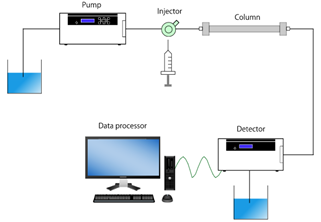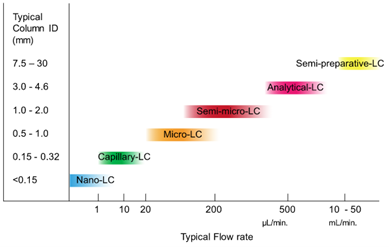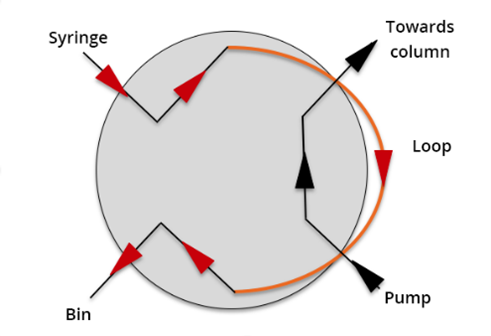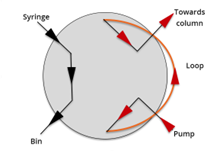Basic System Configuration of HPLC
A High-Performance Liquid Chromatography (HPLC) system consists of five main parts: a pump, an injector, a column, a detector, and a data processor (Fig. 1). A pump, or solvent delivery system, provides a constant flow rate of mobile phase throughout the HPLC system. An injector (manual), or an autosampler (automatic), is used to load and inject a known amount of sample into the HPLC system. A column separates the components of a sample mixture based on their interaction with the stationary and mobile phases. A detector detects components of a sample mixture after separation based on a specific physical or chemical property of the component. A data processor converts and displays the detected electrical signal as a chromatogram allowing identification and quantification of sample components.

HPLC Pumps
Pumps are classified according to their flow rate (Fig. 2):
- Nano pumps: 1 µL/min or less
- Micro pumps: several tens of µL/min
- Semi-micro pumps: several hundreds of µL/min
- Analytical pumps: several mL/min
- Preparative pumps: several tens of mL/min or more
The pump flow rate for normal analysis is several mL/min.

Manual Injection Versus Automatic Sampling
There are two types of sample injector modules: a manual injector and an autosampler. A manual injector requires the user to load and inject the sample via a syringe into the injection valve in the load position to fill the sample loop (Fig. 3). The user then switches the injection valve to the inject position, connecting the sample loop to the pump and column, allowing mobile phase to pass from the pump through the sample loop onto the column (Fig. 4). An autosampler uses an automated injection valve with a mechanism to inject multiple samples sequentially.


Column/Column Oven
The column is where the separation of components in a sample mixture occurs, and this separation is dependent on the temperature of the column. Fluctuations in column temperature will affect sample retention time, selectivity, and peak shape as well as system pressure. To obtain reproducible results, a column oven should be used to keep the column at a constant temperature. A column oven can also be used to increase or decrease the temperature of the column to improve separation. As the temperature of the column increases, the solubility of the sample in the mobile phase increases, resulting in shorter retention times and faster run times. It also decreases the mobile phases viscosity, resulting in a decrease in system pressure, allowing the flow rate of the mobile phase to be increased, which also results shorter retention times and faster run times.
Types of Detectors
As shown in Table 1, there are a variety of detectors that can be used depending on your application needs and the target sample. Ultraviolet (UV) and Photodiode Array (PDA) detectors are commonly used since they cover a wide range of applications and components. When higher sensitivity is required, a fluorescence detector or a Mass Spectrometer (MS) can be used. For a more universal detection of compounds that don’t absorb, or fluorescence, an Evaporative Light-Scattering Detector (ELSD) or a Differential Refractive-Index (DRI) detector is more appropriate.
| Detector Type | Measurement Principle |
|---|---|
| UV/Visible Detector | Absorbance (AU) |
| Photodiode Array (PDA) Detector | Absorbance (AU) |
| Differential Refractive Index (RI) Detector | Refractive Index (RI) |
| Fluorescence Detector | Fluorescence |
| Electrochemical Detector | Oxidation / Reduction |
| Electrical Conductivity Detector | Conductivity |
| Mass Spectrometry Detector | Mass-to-Charge Ratio (m/z) |
| Optical Rotation Detector | Optical Rotation (OR) |
| Circular Dichroism Detector | Circular Dichroism (CD) |
| Evaporative Light Scattering Detector | Light Scattering |
